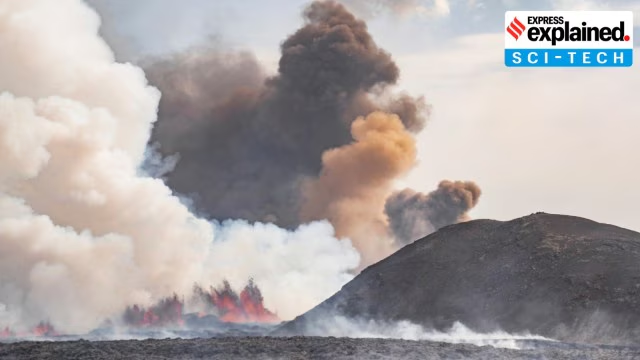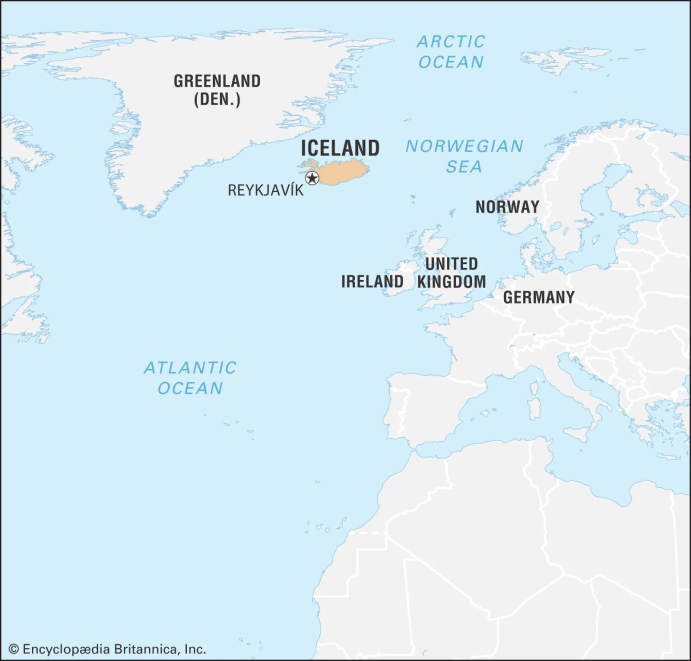Description

Copyright infringement not intended
Picture Courtesy: https://indianexpress.com/article/explained/explained-sci-tech/volcano-in-iceland-erupts-why-is-the-country-so-volcanically-active-9365554/
Context: Sundhnuksgigar volcano in southwest Iceland erupted on May 29, causing evacuations of Grindavik and the Blue Lagoon spa.
Iceland's Volcanic Activity and Types
- Iceland is one of the most volcanically active regions globally, with an eruption frequency of nearly one per year since 2021.
- The volcano, Sundhnuksgigar, in southwest Iceland, erupted on May 29, leading to evacuations of Grindavik and the popular Blue Lagoon spa. Volcanoes are openings where lava, tephra, and steam erupt onto the Earth's surface.
- The rise of magma can occur when tectonic plates move away from each other, plates move towards each other, or at hotspots.
- The type of volcano depends on the viscosity of the magma, the amount of gas in the magma, the composition of the magma, and how the magma reaches the surface.
- Iceland's volcanic activity is due to its location on the Mid-Atlantic Ridge in the North Atlantic Ocean, where the Eurasian and North American plates are moving apart. This produces volcanic rift zones where molten rock, or magma, rises and erupts as lava and/or ash.
- The island's location over a hot zone leads to enhanced volcanic activity in the region.

About Iceland
- Iceland is a Nordic island country located between the North Atlantic and Arctic Oceans, on the Mid-Atlantic Ridge.
- The capital and largest city is Reykjavík, home to about 36% of the country's residents.
- Iceland's geologic activity includes geysers and frequent volcanic eruptions.
- The interior consists of a volcanic plateau, mountains, and glaciers, with many glacial rivers flowing to the sea.
- Iceland is part of the Mid-Atlantic Ridge, a ridge where the oceanic crust spreads and forms new crust.
- Iceland has three national parks: Vatnajökull National Park, Snaefellsjökull National Park, and Þingvellir National Park
- Iceland's climate is temperate, with high latitude and marine influence keeping summers chilly.
- The most common tree native to Iceland is the northern birch, along with aspens, rowans, common junipers, and other smaller trees.
- The Arctic fox is the only indigenous land mammal in Iceland. Other animals include Icelandic sheep, cattle, chickens, goats, the sturdy Icelandic horse, and the Icelandic Sheepdog.
- Iceland has a market economy with relatively low taxes and the highest trade union membership in the world.
- It maintains a Nordic social welfare system providing universal health care and tertiary education for its citizens.

Source:
Indian Express
Wikipedia
|
PRACTICE QUESTION
Q. Iceland's landscape is dominated by volcanic features. Which of the following are likely to be found in Iceland?
1. Active and dormant volcanoes
2. Extensive lava fields and geothermal hot springs
3. Glaciers and ice caps due to high latitude
How many of the above statements are correct?
A) Only one
B) Only two
C) All three
D) None
Answer: C
|













